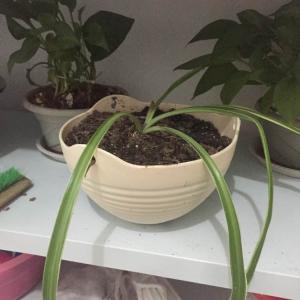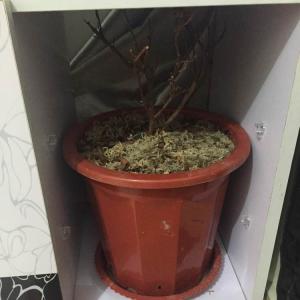文章
我家狗狗会尖叫
2017年07月13日

播种
在3月底4月初温室里进行第一批育苗,由于杂交制种,此时可先播母本和一期父本,待一个月后再播二期父本,这样可保证后期授粉质量。把准备好的床土首先进行土壤消毒,可用高锰酸钾、福尔马林、敌克松等,配成适当比例的水溶液喷洒苗床。床土经过细筛筛过,床平整好,浇足底水,待水渗下后,将种子均匀地撒播在苗床上,种子每克750粒,播前最好做一下催芽处理。种子撒播完毕后,把准备好的砂性土均匀筛在苗床上,覆土厚度为0.3㎝,然后用塑料薄膜、拱棚式覆盖,约经7—10日即能发芽成苗。

苗期管理
待苗长出后,要精心管理,这时温室温度较高,注意控水,避免小苗徒长。当苗长到6—7㎝高时进行移栽,可移栽营养钵内,当苗长到10㎝时,可直接定植在制种棚内,整个制种在保护地塑料大棚内进行。定植前施足底肥,肥料使用N、P、K复合肥为好,株行距按30×30㎝进行栽植,在栽植方式上采用高畦栽植,这样有利于排水、通风透气,避免病虫害发生。栽植地一亩可植6000株苗,父母本比例为1:2较合适,这样即有丰足的产量,又能合理地利用父本花。定植后,要注意浇水、施肥、通风、病虫害的防治等管理。浇水根据苗期的不同,浇水量也不同,视土壤情况而定。定植后一个月开始追肥,少量施复合肥,农家肥更佳,保证苗期茁状成长,福禄考苗期易感染,猝倒病、根腐病等。为避免病虫害发生,一周打一次药,多以防真菌感染病害,通常使用波尔多液、多菌灵、百菌清等。3杂交授粉首先去雄,由于福禄考为两性花,避免母本自花授粉,在母本柱头未开裂前,将雄蕊全部摘除掉。授粉方式有两种:一种为取来父本花,用小镊子将5个花粉粒,分别放到4—5个雌蕊柱上,这样较费人工,但结籽率较好,产量较高,亩产可达6公斤以上。另一种授粉方法为筒授法,必须在父本散粉的条件下,边去雄授粉,在柱头未开裂去掉花冠,剩下花的基部全筒状(花筒)将有粉部分露出。用有粉部分接触柱头,进行授粉,这种方法较省人工,结实率高,速度快,但产量较一前种低一些。杂交时期避免温度过高,超过30℃则影响座果及种子含量,授粉时间整天都可进行,花粉量充足,授粉后可于花朵上摘去一片萼片,以做日后采收种子时之识别。4种子采收专人负责及时采收,在花朵经困杂交后约4—5周便可采收种子。掉落地上的种子,宁可舍去,以免混杂。种子采收后标上品种名称,装种子的容器必须干净,晒种时各品种应间隔一定距离,以免被风吹动而混杂。把采收种置于阴凉处凉晒。
播种育苗
播种育苗:种子较小,每克约550-600粒。可以直播于育苗盘,采用轻质的播种介质。播种后略盖土,常采用细粒蛭石,有助于保持湿润,同时喷洒杀菌剂防止小苗得病。最佳的发芽温度为20-22℃,土温对种子发芽的影响很大,应加倍控制。一般7-14天可以出苗。特别注意小苗不耐移植。播种育苗的时间因地而异。北方地区可以在2月初播种,5月以后开花。
在3月底4月初温室里进行第一批育苗,由于杂交制种,此时可先播母本和一期父本,待一个月后再播二期父本,这样可保证后期授粉质量。把准备好的床土首先进行土壤消毒,可用高锰酸钾、福尔马林、敌克松等,配成适当比例的水溶液喷洒苗床。床土经过细筛筛过,床平整好,浇足底水,待水渗下后,将种子均匀地撒播在苗床上,种子每克750粒,播前最好做一下催芽处理。种子撒播完毕后,把准备好的砂性土均匀筛在苗床上,覆土厚度为0.3㎝,然后用塑料薄膜、拱棚式覆盖,约经7—10日即能发芽成苗。

苗期管理
待苗长出后,要精心管理,这时温室温度较高,注意控水,避免小苗徒长。当苗长到6—7㎝高时进行移栽,可移栽营养钵内,当苗长到10㎝时,可直接定植在制种棚内,整个制种在保护地塑料大棚内进行。定植前施足底肥,肥料使用N、P、K复合肥为好,株行距按30×30㎝进行栽植,在栽植方式上采用高畦栽植,这样有利于排水、通风透气,避免病虫害发生。栽植地一亩可植6000株苗,父母本比例为1:2较合适,这样即有丰足的产量,又能合理地利用父本花。定植后,要注意浇水、施肥、通风、病虫害的防治等管理。浇水根据苗期的不同,浇水量也不同,视土壤情况而定。定植后一个月开始追肥,少量施复合肥,农家肥更佳,保证苗期茁状成长,福禄考苗期易感染,猝倒病、根腐病等。为避免病虫害发生,一周打一次药,多以防真菌感染病害,通常使用波尔多液、多菌灵、百菌清等。3杂交授粉首先去雄,由于福禄考为两性花,避免母本自花授粉,在母本柱头未开裂前,将雄蕊全部摘除掉。授粉方式有两种:一种为取来父本花,用小镊子将5个花粉粒,分别放到4—5个雌蕊柱上,这样较费人工,但结籽率较好,产量较高,亩产可达6公斤以上。另一种授粉方法为筒授法,必须在父本散粉的条件下,边去雄授粉,在柱头未开裂去掉花冠,剩下花的基部全筒状(花筒)将有粉部分露出。用有粉部分接触柱头,进行授粉,这种方法较省人工,结实率高,速度快,但产量较一前种低一些。杂交时期避免温度过高,超过30℃则影响座果及种子含量,授粉时间整天都可进行,花粉量充足,授粉后可于花朵上摘去一片萼片,以做日后采收种子时之识别。4种子采收专人负责及时采收,在花朵经困杂交后约4—5周便可采收种子。掉落地上的种子,宁可舍去,以免混杂。种子采收后标上品种名称,装种子的容器必须干净,晒种时各品种应间隔一定距离,以免被风吹动而混杂。把采收种置于阴凉处凉晒。
播种育苗
播种育苗:种子较小,每克约550-600粒。可以直播于育苗盘,采用轻质的播种介质。播种后略盖土,常采用细粒蛭石,有助于保持湿润,同时喷洒杀菌剂防止小苗得病。最佳的发芽温度为20-22℃,土温对种子发芽的影响很大,应加倍控制。一般7-14天可以出苗。特别注意小苗不耐移植。播种育苗的时间因地而异。北方地区可以在2月初播种,5月以后开花。
0
1
文章
Dummer. ゛☀
2017年07月13日

Family - Asteraceae
Stems - To +20cm tall, herbaceous, stoloniferous, with fibrous roots, dense lanate, simple, erect.
Leaves - Basal leaves petiolate. Petioles to 3-4cm long. Blade to +4cm long, +2cm broad, tapering at base, entire, broadly elliptic, dense white lanate below, sparse lanate above and greenish, with 3 main veins(visible below). Cauline leaves sessile, linear to linear lanceolate, lanate below, very sparse lanate above, to 2cm long, 5mm broad, entire.
Inflorescence - Flower heads in compact clusters terminating stems. Plants dioecious.
Involucre - To 5mm tall(long), 3-5mm in diameter, densely arachnoid pubescent. Phyllaries to 5mm long, 1.2mm broad, green with scarious margins and long scarious apex, glabrous internally, in 1-2 series, imbricate. Staminate involucre slightly more broad and short than pistillate.
Ray flowers - Absent.
Disk flowers - Pistillate flowers - Corolla tube greenish, glabrous, 4.5mm long. Style bifurcate, exserted, purplish at apex. Achenes cylindric, glandular pubescent, 1.6mm long in flower. Pappus a single series of barbellate bristles. Bristles white, to 5-6mm long. Receptacle conic, naked. Staminate flowers, (shown at top of page), - Corolla tube greenish, glabrous, 2.5mm long, expanded at apex for -2mm, 5-lobed. Lobes acute, .6mm long, often recurved. Stamens 5, adnate at base of corolla tube. Anthers exserted, brownish-purple, -2mm long, connate around rudimentary style. The style slightly exserted beyond the anthers. Pappus of barbellate bristles in a single series, to 4mm long. Achenes reduced. Receptacle conic, naked.
Flowering - April - June.
Habitat - Acid soils of dry rocky ground, ravines, thickets, roadsides, ridges, prairies, glades.
Origin - Native to U.S.
Other info. - This is a common little plant in Missouri and is easy to ID in the field. The species name means "leaves of Plantain" and indeed the basal leaves do look like those of the genus Plantago. Even though the plants are dioecious, the pistillate plants can still produce viable seed without fertilization from the staminate plants.
Stems - To +20cm tall, herbaceous, stoloniferous, with fibrous roots, dense lanate, simple, erect.
Leaves - Basal leaves petiolate. Petioles to 3-4cm long. Blade to +4cm long, +2cm broad, tapering at base, entire, broadly elliptic, dense white lanate below, sparse lanate above and greenish, with 3 main veins(visible below). Cauline leaves sessile, linear to linear lanceolate, lanate below, very sparse lanate above, to 2cm long, 5mm broad, entire.

Inflorescence - Flower heads in compact clusters terminating stems. Plants dioecious.
Involucre - To 5mm tall(long), 3-5mm in diameter, densely arachnoid pubescent. Phyllaries to 5mm long, 1.2mm broad, green with scarious margins and long scarious apex, glabrous internally, in 1-2 series, imbricate. Staminate involucre slightly more broad and short than pistillate.

Ray flowers - Absent.
Disk flowers - Pistillate flowers - Corolla tube greenish, glabrous, 4.5mm long. Style bifurcate, exserted, purplish at apex. Achenes cylindric, glandular pubescent, 1.6mm long in flower. Pappus a single series of barbellate bristles. Bristles white, to 5-6mm long. Receptacle conic, naked. Staminate flowers, (shown at top of page), - Corolla tube greenish, glabrous, 2.5mm long, expanded at apex for -2mm, 5-lobed. Lobes acute, .6mm long, often recurved. Stamens 5, adnate at base of corolla tube. Anthers exserted, brownish-purple, -2mm long, connate around rudimentary style. The style slightly exserted beyond the anthers. Pappus of barbellate bristles in a single series, to 4mm long. Achenes reduced. Receptacle conic, naked.
Flowering - April - June.
Habitat - Acid soils of dry rocky ground, ravines, thickets, roadsides, ridges, prairies, glades.
Origin - Native to U.S.
Other info. - This is a common little plant in Missouri and is easy to ID in the field. The species name means "leaves of Plantain" and indeed the basal leaves do look like those of the genus Plantago. Even though the plants are dioecious, the pistillate plants can still produce viable seed without fertilization from the staminate plants.
0
0
文章
Dummer. ゛☀
2017年07月13日

Family - Ranunculaceae
Stems - To +30cm tall, from rhizomes, herbaceous, erect, terete, sparse sericeous, simple.
Leaves - Basal leaves palmately divided into 3-5 lobes. Lobes divided again, toothed near apex, typically entire in lower half, sericeous below, less so above, +/-12cm broad and long. Petioles to +/-15cm long, sericeous. Cauline leaves(involucre bracts) sessile, 3-lobed, 8-9cm broad and long, sericeous. Lobes again divided, toothed near apex, entire in lower half.
Inflorescence - Single flowers or loose cymes terminating stems. Pedicels to +8cm long, sericeous, 1.5mm in diameter.
Flowers - To -5cm broad. Petaloid sepals 5, white, glabrous, obovate to elliptic, equal or subequal, obtuse or emarginate at apex, to +2cm long, +1.5cm broad. Stamens many(+100), borne beneath pistils. Filaments glabrous. Anthers yellow, to +1mm long.
Flowering - May - July.
Habitat - Low moist ground, flood plains, low woods.
Origin - Native to U.S.
Other info. - The big white flowers and palmate leaves of this plant are unmistakable. The plant is common and can be found in large colonies. Because it favors locations near water, you may encounter other interesting species when hunting the plant. One such species is Nerodia sipedon sipedon. This specimen was basking itself on a warm gravel road after a cool night:
Stems - To +30cm tall, from rhizomes, herbaceous, erect, terete, sparse sericeous, simple.

Leaves - Basal leaves palmately divided into 3-5 lobes. Lobes divided again, toothed near apex, typically entire in lower half, sericeous below, less so above, +/-12cm broad and long. Petioles to +/-15cm long, sericeous. Cauline leaves(involucre bracts) sessile, 3-lobed, 8-9cm broad and long, sericeous. Lobes again divided, toothed near apex, entire in lower half.
Inflorescence - Single flowers or loose cymes terminating stems. Pedicels to +8cm long, sericeous, 1.5mm in diameter.
Flowers - To -5cm broad. Petaloid sepals 5, white, glabrous, obovate to elliptic, equal or subequal, obtuse or emarginate at apex, to +2cm long, +1.5cm broad. Stamens many(+100), borne beneath pistils. Filaments glabrous. Anthers yellow, to +1mm long.

Flowering - May - July.
Habitat - Low moist ground, flood plains, low woods.
Origin - Native to U.S.
Other info. - The big white flowers and palmate leaves of this plant are unmistakable. The plant is common and can be found in large colonies. Because it favors locations near water, you may encounter other interesting species when hunting the plant. One such species is Nerodia sipedon sipedon. This specimen was basking itself on a warm gravel road after a cool night:
0
0
文章
金达威
2017年07月12日

1、浇水太少
#栀子花 喜水,夏季蒸发量非常大,通常叶子发黄是水跟不上造成的。
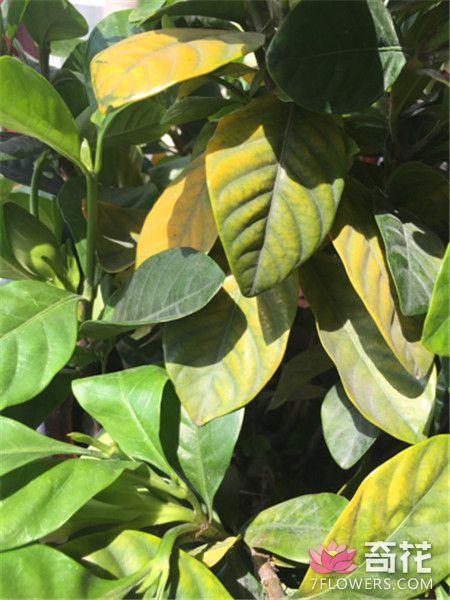
解决方法
室内养殖的栀子花大概2~3天就得浇一次水,如果是直接露养的,那大概1~2天就得浇一次水。
2、土壤偏碱
栀子花喜欢微酸性的土壤,但是北方的土壤一般都偏碱,就算是一开始不偏碱,一直浇自来水也会慢慢变碱。
解决方法
用1:1000~2000的硫酸亚铁溶液直接灌根,半个月或者是1个月1次都行~
#栀子花 喜水,夏季蒸发量非常大,通常叶子发黄是水跟不上造成的。

解决方法
室内养殖的栀子花大概2~3天就得浇一次水,如果是直接露养的,那大概1~2天就得浇一次水。
2、土壤偏碱
栀子花喜欢微酸性的土壤,但是北方的土壤一般都偏碱,就算是一开始不偏碱,一直浇自来水也会慢慢变碱。
解决方法
用1:1000~2000的硫酸亚铁溶液直接灌根,半个月或者是1个月1次都行~
1
5
文章
Dummer. ゛☀
2017年07月12日

Family - Caprifoliaceae
Stems - Woody, multiple or sometimes a single trunk. A shrub or small tree to 4m tall. Twigs glabrous.
Leaves - Opposite, petiolate, 3-lobed, margins toothed or sometimes entire, glabrous above, sparsely pubescent below. Petiole glabrous, to 3cm long.
Inflorescence - Terminal, flat-topped cymes. Compound and resembling umbels, to +13cm broad. Stalks glabrous to very sparsely pubescent.
Flowers - Outer flowers sterile, white, to 2.5cm broad, slightly irregular, 5-lobed. Inner flowers fertile. Corolla to 5mm broad, white, 5-lobed, externally glabrous, internally sparsely pubescent. Lobes rounded, 2mm broad, 1mm long. Corolla tube campanulate, 3mm broad, 1.7mm long. Stamens 5, alternating with corolla lobes, erect, well exserted beyond corolla. Filaments to 5mm long, white, glabrous. Anthers tan, .7mm long.
Fruits - Red, globose to subglobose, single-seeded (drupes), to 12mm in diameter, 15mm long.
Flowering - June - July.
Habitat - Moist to wet soils of lake margins, slopes, or open woods. Also cultivated.
Origin - Native to U.S. and Europe.
Other info. - The variety americanus Ait. is commonly known as V. trilobum Marsh. - Rydberg.
This is the variety found growing wild here in the U.S. and pictured above. Other varieties from Europe are commonly cultivated here in the States. The next plant in this list, V. opulus var. roseum "Snowball", is just one of them.
Stems - Woody, multiple or sometimes a single trunk. A shrub or small tree to 4m tall. Twigs glabrous.
Leaves - Opposite, petiolate, 3-lobed, margins toothed or sometimes entire, glabrous above, sparsely pubescent below. Petiole glabrous, to 3cm long.

Inflorescence - Terminal, flat-topped cymes. Compound and resembling umbels, to +13cm broad. Stalks glabrous to very sparsely pubescent.

Flowers - Outer flowers sterile, white, to 2.5cm broad, slightly irregular, 5-lobed. Inner flowers fertile. Corolla to 5mm broad, white, 5-lobed, externally glabrous, internally sparsely pubescent. Lobes rounded, 2mm broad, 1mm long. Corolla tube campanulate, 3mm broad, 1.7mm long. Stamens 5, alternating with corolla lobes, erect, well exserted beyond corolla. Filaments to 5mm long, white, glabrous. Anthers tan, .7mm long.
Fruits - Red, globose to subglobose, single-seeded (drupes), to 12mm in diameter, 15mm long.
Flowering - June - July.
Habitat - Moist to wet soils of lake margins, slopes, or open woods. Also cultivated.
Origin - Native to U.S. and Europe.
Other info. - The variety americanus Ait. is commonly known as V. trilobum Marsh. - Rydberg.
This is the variety found growing wild here in the U.S. and pictured above. Other varieties from Europe are commonly cultivated here in the States. The next plant in this list, V. opulus var. roseum "Snowball", is just one of them.
0
0
文章
Dummer. ゛☀
2017年07月12日

Family - Liliaceae
Stems - From a rhizome and thickened roots, to -15cm tall, erect, single from the base, simple, herbaceous, glabrous, reddish, somewhat 5-angled.
Leaves - 3, whorled, petiolate. Petioles 3-4mm long, mostly glabrous but minutely translucent papillate on the margins (use a lens to see). Blades ovate, to +3cm long, +1.5cm broad, shiny silvery-green below, pale bluish-green above, glabrous above, translucent papillate below, acute to subacute at the apex, entire, with papillae on the margins (use a lens to see papillae), with 5 main veins. Lateral veins reticulate. Veins impressed above, expressed below.
Inflorescence - Single flower terminating the stem. Peduncle to +1.5cm long, glabrous, purplish. Flowers nodding slightly or erect.
Flowers - Petals 3, white, glabrous, to 3cm long, +1cm broad, oblong to elliptic, entire, blunt to slightly emarginate at the apex, tapering to the base, distinct. Stamens 6, alternating smaller and larger, erect, distinct. Filaments to 5mm long, -1mm broad, white, slightly compressed. Anthers yellow, to +6mm long, -2mm broad, longitudinally dehiscing. Anther connective greenish. Styles 3, erect. curled at the apex, to 1cm long, white at the apex, yellow to greenish basally, distinct. Ovary sessile, yellowish, superior, glabrous, 3-lobed, 3mm long and broad, 3-locular, with many ovules. Placentation axile. Sepals 3, green, slightly spreading, +/-2cm long, 5-6mm broad, lanceolate, blunt to slightly emarginate at the apex, with 5 parallel veins, with a scarious margin .1mm thick, glabrous.
Flowering - March - April.
Habitat - Mesic upland forests on steep, open, north-facing slopes above streams and rivers - on limestone and chert substrates.
Origin - Native to U.S.
Other info. - This small species is the smallest Trillium in Missouri and the first to bloom each spring. The plant is uncommon in the state and can only be found in a handful of counties. Its very selective habitat limits its range in Missouri.
T. nivale is an easy species to identify in the field (if you're lucky enough to find it) because of its small size, habitat, and white flowers. Plants are usually found in large numbers in a given area.
Stems - From a rhizome and thickened roots, to -15cm tall, erect, single from the base, simple, herbaceous, glabrous, reddish, somewhat 5-angled.

Leaves - 3, whorled, petiolate. Petioles 3-4mm long, mostly glabrous but minutely translucent papillate on the margins (use a lens to see). Blades ovate, to +3cm long, +1.5cm broad, shiny silvery-green below, pale bluish-green above, glabrous above, translucent papillate below, acute to subacute at the apex, entire, with papillae on the margins (use a lens to see papillae), with 5 main veins. Lateral veins reticulate. Veins impressed above, expressed below.

Inflorescence - Single flower terminating the stem. Peduncle to +1.5cm long, glabrous, purplish. Flowers nodding slightly or erect.
Flowers - Petals 3, white, glabrous, to 3cm long, +1cm broad, oblong to elliptic, entire, blunt to slightly emarginate at the apex, tapering to the base, distinct. Stamens 6, alternating smaller and larger, erect, distinct. Filaments to 5mm long, -1mm broad, white, slightly compressed. Anthers yellow, to +6mm long, -2mm broad, longitudinally dehiscing. Anther connective greenish. Styles 3, erect. curled at the apex, to 1cm long, white at the apex, yellow to greenish basally, distinct. Ovary sessile, yellowish, superior, glabrous, 3-lobed, 3mm long and broad, 3-locular, with many ovules. Placentation axile. Sepals 3, green, slightly spreading, +/-2cm long, 5-6mm broad, lanceolate, blunt to slightly emarginate at the apex, with 5 parallel veins, with a scarious margin .1mm thick, glabrous.
Flowering - March - April.
Habitat - Mesic upland forests on steep, open, north-facing slopes above streams and rivers - on limestone and chert substrates.
Origin - Native to U.S.
Other info. - This small species is the smallest Trillium in Missouri and the first to bloom each spring. The plant is uncommon in the state and can only be found in a handful of counties. Its very selective habitat limits its range in Missouri.
T. nivale is an easy species to identify in the field (if you're lucky enough to find it) because of its small size, habitat, and white flowers. Plants are usually found in large numbers in a given area.
0
0
文章
Dummer. ゛☀
2017年07月11日

Family - Caryophyllaceae
Stems - To -30cm tall, multiple from the base, herbaceous, erect, simple, glandular pubescent in the internodes, from a small taproot.
Leaves - Opposite, sessile, +/-3 pairs per stem, ovate-lanceolate, glandular pubescent on the margins, entire, sub-acute, +/-2cm long, 5-6mm broad, more linear at the base of the plant, light blue-green. Opposing pairs of leaves joined at the base and enclosing the stem.
Inflorescence - Terminal umbel of 5-10 flowers. Pedicels glabrous and filiform, to -2cm long, erect in flower, drooping later, erect again in fruit. Umbels subtended by minute involucre of connate bracts. Bracts acute, the free portion to 1mm long, glabrous.
Flowers - Petals 5, distinct, white, erose at the apex, +/-4mm long, 2mm broad, tapering to a short claw at the base, glabrous. Stamens 5, erect. Filaments white, glabrous, to -3mm long. Anthers pale yellow, .4mm long, globose. Ovary superior, light green, glabrous, ovoid, 1.5mm long, 1mm in diameter, unilocular, many-ovuled. Placentation free-central. Styles 3, distinct, 1mm long. Sepals 5, ovate-lanceolate, glabrous internally and externally, green, with scarious margins, accrescent, to 3mm long, 1.6mm broad in flower, acute, entire. Capsule to 5mm long, apically dehiscent, brown, scarious, 6-lobed at apex. Seeds ferruginous, 1mm long, glabrous.
Flowering - March - May.
Habitat - Roadsides, railroads, waste places.
Origin - Native to Europe.
Other info. - This little species can be found throughout Missouri. The plant is easy to ID in the field because of its small size and terminal umbellate inflorescence. The plant has a short growing season and dries quickly after flowering. It can be found in quantity when growing undisturbed.
Stems - To -30cm tall, multiple from the base, herbaceous, erect, simple, glandular pubescent in the internodes, from a small taproot.
Leaves - Opposite, sessile, +/-3 pairs per stem, ovate-lanceolate, glandular pubescent on the margins, entire, sub-acute, +/-2cm long, 5-6mm broad, more linear at the base of the plant, light blue-green. Opposing pairs of leaves joined at the base and enclosing the stem.

Inflorescence - Terminal umbel of 5-10 flowers. Pedicels glabrous and filiform, to -2cm long, erect in flower, drooping later, erect again in fruit. Umbels subtended by minute involucre of connate bracts. Bracts acute, the free portion to 1mm long, glabrous.
Flowers - Petals 5, distinct, white, erose at the apex, +/-4mm long, 2mm broad, tapering to a short claw at the base, glabrous. Stamens 5, erect. Filaments white, glabrous, to -3mm long. Anthers pale yellow, .4mm long, globose. Ovary superior, light green, glabrous, ovoid, 1.5mm long, 1mm in diameter, unilocular, many-ovuled. Placentation free-central. Styles 3, distinct, 1mm long. Sepals 5, ovate-lanceolate, glabrous internally and externally, green, with scarious margins, accrescent, to 3mm long, 1.6mm broad in flower, acute, entire. Capsule to 5mm long, apically dehiscent, brown, scarious, 6-lobed at apex. Seeds ferruginous, 1mm long, glabrous.

Flowering - March - May.
Habitat - Roadsides, railroads, waste places.
Origin - Native to Europe.
Other info. - This little species can be found throughout Missouri. The plant is easy to ID in the field because of its small size and terminal umbellate inflorescence. The plant has a short growing season and dries quickly after flowering. It can be found in quantity when growing undisturbed.
0
0
文章
Colour_
2017年07月11日
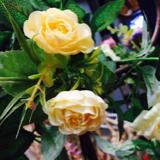
管花杜鹃形态特征
常绿直立灌木,高1-4(--6)米。枝条细长,幼枝带紫红色,疏生鳞片。叶散生 幼枝上,披针状椭圆形或披针状长圆形,长(3--)4-8(--15)厘米,宽1-3(--4) 厘米,顶端锐尖,基部楔形,上面暗绿色,有光泽,被褐色鳞片,鳞片相距为其直径的 1--3倍,下面苍绿色,被密而不等大的褐色至暗褐色的鳞片,相距为其直径或不及,侧脉明显;叶柄长5-12毫米,被鳞片。花序顶生或腋生,短总状,通常有4-6花;花梗长4-8毫米,纤细,带红色,有鳞片;花萼小,长约1毫米,浅5裂或仅为边檐 状,无鳞片;花冠管状,一面稍臌胀,长1.8-2.5厘米,橘红、朱红或肉红色,口部 浅5裂,裂片长圆形,直立;雄蕊10,花药短小,卵圆形,花丝下部被密毛;花柱下 部常被毛,偶尔无毛。蒴果长圆形,长8-10毫米,密被鳞片。花期7月,果期10 月。

管花杜鹃的繁殖方式
扦插繁殖
扦插繁殖是杜鹃花栽培中应用最多的繁殖方法,一般在5-6月份剪取健壮的半木质化的新枝,长约5-8厘米,剪除下部叶片,保留顶叶2-3片作插穗,插穗基部最好用吲哚丁酸或ABT生根粉等溶液浸蘸处理,然后扦插在疏松透气、富含腐植质的酸性土壤中,温度保持在20-25℃,遮阴并经常喷雾保湿,以促进萌发新根。
嫩枝繁殖
嫩枝繁殖是用劈接对于难以成活的名贵品种如西鹃等,先剪去嫩枝约3-4厘米作接穗,将基部用利刀削成楔形,用毛鹃作砧木,采用嫩枝劈接,然后置阴棚下用塑料薄膜绑扎,并用塑料袋将接穗和砧木一起罩住保湿。

管花杜鹃的养殖方法
肥水管理
杜鹃生长发育要求酸性土壤。由于北方土壤多偏碱性,因此盆土需用腐熟的松针叶土等腐植土混合配制。杜鹃的根系为须状细根,对肥料浓度及水质的要求严格,施肥时要遵循适时适量、薄肥勤施的原则。春季开花前为促使枝叶及花蕾生长,可每月追施一次磷肥。花后施1-2次氮磷为主的混合肥料。9-10月份孕蕾期施1-2次磷肥。在生长期、开花期肥水要求较多,冬季休眠、夏季生长缓慢时要控制肥水,以防烂根。杜鹃花喜湿润和凉爽的环境,北方气候干燥,应及时浇水并喷雾,以保持较高空气湿度。浇花水以矾肥水及雨水为好,如用常用水需加入少量硫酸亚铁及食醋。也可将西瓜或西红柿切成小块施入,对于改善土质及花朵质量也有良好效果。
整形修剪
为加速植株盛开,杜鹃常通过摘心来促发新枝,对于花朵簇拥、影响花形的可以提早疏蕾,这样不但使当年花大色鲜,也有利于植株来年生长开花。杜鹃萌发力强,枝条严重影响植株生长发育,降低其观赏性和商品性,因此需通过修枝来调整。修枝一般在春季花谢后及秋季进行,剪去枯枝、斜枝、徒长枝病虫枝及部分交叉枝,避免养分消耗,使整个植株开花丰满。
花期控制
杜鹃在秋季进行花芽分化,通过冷藏和加温处理,可以人为控制花期。要使杜鹃提前开花,可将其移至温室培养,控温在20-25℃,并经常在枝叶上喷水,保持80%以上的相对湿度,这样经过一个半月即可开花。要使杜鹃延迟开花,可将形成花蕾的杜鹃,让其一直处于低温状态,保持温度2-4℃,盆干时浇水,夏秋移出室外,2周后即可开花。
常绿直立灌木,高1-4(--6)米。枝条细长,幼枝带紫红色,疏生鳞片。叶散生 幼枝上,披针状椭圆形或披针状长圆形,长(3--)4-8(--15)厘米,宽1-3(--4) 厘米,顶端锐尖,基部楔形,上面暗绿色,有光泽,被褐色鳞片,鳞片相距为其直径的 1--3倍,下面苍绿色,被密而不等大的褐色至暗褐色的鳞片,相距为其直径或不及,侧脉明显;叶柄长5-12毫米,被鳞片。花序顶生或腋生,短总状,通常有4-6花;花梗长4-8毫米,纤细,带红色,有鳞片;花萼小,长约1毫米,浅5裂或仅为边檐 状,无鳞片;花冠管状,一面稍臌胀,长1.8-2.5厘米,橘红、朱红或肉红色,口部 浅5裂,裂片长圆形,直立;雄蕊10,花药短小,卵圆形,花丝下部被密毛;花柱下 部常被毛,偶尔无毛。蒴果长圆形,长8-10毫米,密被鳞片。花期7月,果期10 月。

管花杜鹃的繁殖方式
扦插繁殖
扦插繁殖是杜鹃花栽培中应用最多的繁殖方法,一般在5-6月份剪取健壮的半木质化的新枝,长约5-8厘米,剪除下部叶片,保留顶叶2-3片作插穗,插穗基部最好用吲哚丁酸或ABT生根粉等溶液浸蘸处理,然后扦插在疏松透气、富含腐植质的酸性土壤中,温度保持在20-25℃,遮阴并经常喷雾保湿,以促进萌发新根。
嫩枝繁殖
嫩枝繁殖是用劈接对于难以成活的名贵品种如西鹃等,先剪去嫩枝约3-4厘米作接穗,将基部用利刀削成楔形,用毛鹃作砧木,采用嫩枝劈接,然后置阴棚下用塑料薄膜绑扎,并用塑料袋将接穗和砧木一起罩住保湿。

管花杜鹃的养殖方法
肥水管理
杜鹃生长发育要求酸性土壤。由于北方土壤多偏碱性,因此盆土需用腐熟的松针叶土等腐植土混合配制。杜鹃的根系为须状细根,对肥料浓度及水质的要求严格,施肥时要遵循适时适量、薄肥勤施的原则。春季开花前为促使枝叶及花蕾生长,可每月追施一次磷肥。花后施1-2次氮磷为主的混合肥料。9-10月份孕蕾期施1-2次磷肥。在生长期、开花期肥水要求较多,冬季休眠、夏季生长缓慢时要控制肥水,以防烂根。杜鹃花喜湿润和凉爽的环境,北方气候干燥,应及时浇水并喷雾,以保持较高空气湿度。浇花水以矾肥水及雨水为好,如用常用水需加入少量硫酸亚铁及食醋。也可将西瓜或西红柿切成小块施入,对于改善土质及花朵质量也有良好效果。
整形修剪
为加速植株盛开,杜鹃常通过摘心来促发新枝,对于花朵簇拥、影响花形的可以提早疏蕾,这样不但使当年花大色鲜,也有利于植株来年生长开花。杜鹃萌发力强,枝条严重影响植株生长发育,降低其观赏性和商品性,因此需通过修枝来调整。修枝一般在春季花谢后及秋季进行,剪去枯枝、斜枝、徒长枝病虫枝及部分交叉枝,避免养分消耗,使整个植株开花丰满。
花期控制
杜鹃在秋季进行花芽分化,通过冷藏和加温处理,可以人为控制花期。要使杜鹃提前开花,可将其移至温室培养,控温在20-25℃,并经常在枝叶上喷水,保持80%以上的相对湿度,这样经过一个半月即可开花。要使杜鹃延迟开花,可将形成花蕾的杜鹃,让其一直处于低温状态,保持温度2-4℃,盆干时浇水,夏秋移出室外,2周后即可开花。
0
0
文章
Miss Chen
2017年07月11日


#向日葵 是一种可高达3米的大型年生菊科向日葵属植物,别称向阳花、望日莲、太阳花等,因花序随太阳转动而得名,原产南美洲,为俄罗斯、乌克兰、葡萄牙、秘鲁、玻利维亚的国花,下面我们就一起来看一看向日葵代表什么意思吧!
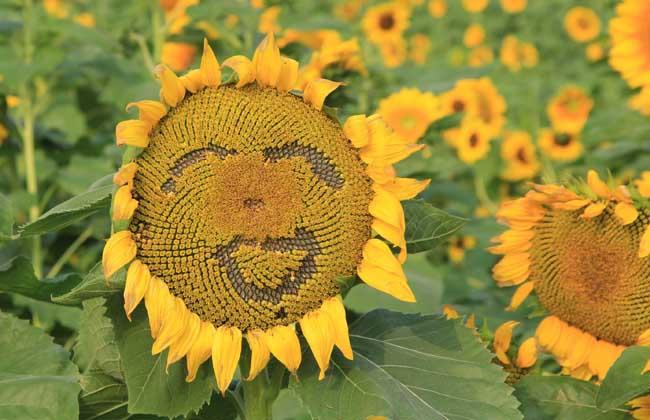
向日葵代表什么意思?
勇敢地去追求自己想要的幸福。向日葵的花语是信念、光辉、高傲、忠诚、爱慕,寓意是沉默的爱,代表着勇敢地去追求自己想要的幸福。向日葵的花姿虽然没有玫瑰那么浪漫,没有百合那么纯净,但阳光、明亮,爱得坦坦荡荡,爱得不离不弃,有着属于自己的独特魅力,而且绽放的不仅是爱情,还有对梦想、对生活的热爱。

向日葵为何向着太阳?
向日葵在阳光的照射下生长素在背光一面含量升高,刺激背光面细胞拉长向太阳转动。在太阳落山后,生长素重新分布,使向日葵转回东方。同时向日葵的花托部生长素背光分布,因而背光侧的茎生长较快,茎会向光源处弯曲。而且,向日葵向着太阳与重力作用也有着密切关系。

向日葵有哪些传说?
1、传说一:克吕提厄是一位海洋女神,曾是太阳神赫利俄斯的情人,但后来赫利俄斯又爱上波斯公主琉科托厄。怒火中烧的克吕提厄向波斯王俄耳卡摩斯告发了琉科托厄与赫利俄斯的关系。耳卡摩斯下令将不贞的女儿活埋。赫利俄斯得知此事后,彻底断绝了与克吕提厄的来往。痴情的克吕提厄一连数天不吃不喝,凝望着赫利俄斯驾驶太阳车东升西落,日渐憔悴,最终化为一株向阳花(向日葵)。
2、传说二:克丽泰是一位水泽仙女。一天她在树林里遇见了正在狩猎的太阳神阿波罗,她深深为这位俊美的神所着迷,疯狂地爱上了他。可是阿波罗连正眼也不瞧她一下就走了。克丽泰热切地盼望有一天阿波罗能对她说说话,但她却再也没有遇见过他。于是她只能每天注视着天空,看着阿波罗驾着金碧辉煌的日车划过天空。她目不转睛地注视着阿波罗的行程,直到他下山。每天每天,她就这样呆坐着,头发散乱,面容憔悴。一到日出,她便望向太阳。后来,众神怜悯她,把她变成一大朵金黄色的向日葵。她的脸儿变成了花盘,永远向着太阳,每日追随他----阿波罗,向他诉说她永远不变的恋情和爱慕。因此,向日葵的花语就是——沉默的爱。
3、传说三:古代有一位农夫女儿名叫明姑,她憨厚老实,长得俊俏,却被后娘“女霸王”视为眼中钉,受到百般凌辱虐待。一次,因一件小事,顶撞了后娘一句,惹怒了后娘,使用皮鞭抽打她,可一下失手打到了前来劝解的亲生女儿身上,这时后娘又气又恨,夜里趁明姑熟睡之际挖掉了她的眼睛。明姑疼痛难忍,破门出逃,不久死去,死后在她坟上开着一盘鲜丽的黄花,终日面向阳光,它就是向日葵。表示明姑向往光明,厌恶黑暗之意,这传说激励人们痛恨暴力、黑暗,追求光明。这向日葵便繁衍至今。
0
0
文章
Dummer. ゛☀
2017年07月11日

Family - Asteraceae
Stems - To +1.5m tall, erect, herbaceous, terete, simple below, branching in the apical 1/3, glabrescent below, tomentose above, green to tan.

Leaves - Opposite, sessile, decussate, often with a smaller pair of leaves in the axils of the larger main leaves, to +10cm long, to 2cm broad, lanceolate to oblong-lanceolate to linear-lanceolate, coarse serrate in the apical 1/2 (at least on the lower leaves), green on both surfaces, with antrorsely bent pubescence, much more pubescent abaxially, with 3 main veins arising at the very base of the leaf blade. Other veins of the leaves anastomosing before the margin of the blade. Margins antrorse ciliolate.
Inflorescence - Multiple flowerheads in a corymbose arrangement terminating the stem. Each division of the inflorescence subtended by a pair of reduced bracts. Bracts foliaceous.
Involucre - 5mm long (tall), +/-2mm in diameter, cylindric. Outer phyllaries smaller than the inner. Inner phyllaries to 5mm long, 1.4mm broad, tomentose externally glabrous internally, with a scarious-white margin, with 3 darker green veins (use a lens to see), with a solid green apex, linear to oblanceolate, rounded at the apex.
Disk flowers - Flowerheads with 4-7 flowers. Corolla white in the apical 1/2, green basally, 4mm long, glabrous internally and externally, expanded in the apical 1/2, 5-lobed. Lobes acute, 1mm long, .5mm broad at the base, erect to spreading. Stamens 5, adnate at the apex of the contracted portion of the corolla tube. Filaments white, glabrous, compressed, .7mm long. Anthers purplish, to 1.2mm long, connate around the style, partially exserted. Style glabrous, green basally, white apically, to +/-6mm long, bifurcate in the apical 3mm (the divisions erect). Achenes green in flower, 2-2.2mm long, glabrous, terete or 5-sided. Pappus of capillary bristles. Bristles antrorse barbellate, white, 4-5mm long. Receptacle naked.
Flowering - August - October.
Habitat - Prairies, glades, thickets, open rocky wood, waste ground, fallow fields.
Origin - Native to U.S.
Other info. - This species can be found throughout much of Missouri but is mostly absent in the southeastern corner of the state. This is a non-distinct plant and many would consider it a weed. "altissimum" means "tallest" but this is not the tallest species of the genus, there are many which generally exceed its height. The plant is not difficult to identify but it can be confused with the similar members of the genus. The tomentose stems, 3 main leaf veins, and rounded phyllaries help to identify it correctly. Plants growing in full sun are much more stout, have more leaves, and have bigger inflorescences than do plants growing in the shade or in wooded areas.
Stems - To +1.5m tall, erect, herbaceous, terete, simple below, branching in the apical 1/3, glabrescent below, tomentose above, green to tan.

Leaves - Opposite, sessile, decussate, often with a smaller pair of leaves in the axils of the larger main leaves, to +10cm long, to 2cm broad, lanceolate to oblong-lanceolate to linear-lanceolate, coarse serrate in the apical 1/2 (at least on the lower leaves), green on both surfaces, with antrorsely bent pubescence, much more pubescent abaxially, with 3 main veins arising at the very base of the leaf blade. Other veins of the leaves anastomosing before the margin of the blade. Margins antrorse ciliolate.

Inflorescence - Multiple flowerheads in a corymbose arrangement terminating the stem. Each division of the inflorescence subtended by a pair of reduced bracts. Bracts foliaceous.
Involucre - 5mm long (tall), +/-2mm in diameter, cylindric. Outer phyllaries smaller than the inner. Inner phyllaries to 5mm long, 1.4mm broad, tomentose externally glabrous internally, with a scarious-white margin, with 3 darker green veins (use a lens to see), with a solid green apex, linear to oblanceolate, rounded at the apex.
Disk flowers - Flowerheads with 4-7 flowers. Corolla white in the apical 1/2, green basally, 4mm long, glabrous internally and externally, expanded in the apical 1/2, 5-lobed. Lobes acute, 1mm long, .5mm broad at the base, erect to spreading. Stamens 5, adnate at the apex of the contracted portion of the corolla tube. Filaments white, glabrous, compressed, .7mm long. Anthers purplish, to 1.2mm long, connate around the style, partially exserted. Style glabrous, green basally, white apically, to +/-6mm long, bifurcate in the apical 3mm (the divisions erect). Achenes green in flower, 2-2.2mm long, glabrous, terete or 5-sided. Pappus of capillary bristles. Bristles antrorse barbellate, white, 4-5mm long. Receptacle naked.
Flowering - August - October.
Habitat - Prairies, glades, thickets, open rocky wood, waste ground, fallow fields.
Origin - Native to U.S.
Other info. - This species can be found throughout much of Missouri but is mostly absent in the southeastern corner of the state. This is a non-distinct plant and many would consider it a weed. "altissimum" means "tallest" but this is not the tallest species of the genus, there are many which generally exceed its height. The plant is not difficult to identify but it can be confused with the similar members of the genus. The tomentose stems, 3 main leaf veins, and rounded phyllaries help to identify it correctly. Plants growing in full sun are much more stout, have more leaves, and have bigger inflorescences than do plants growing in the shade or in wooded areas.
0
0
文章
Dummer. ゛☀
2017年07月11日

Family - Bignoniaceae
Stems - Woody. A tree to 30m tall. Single trunk to 1m in diameter.
Leaves - Opposite or in whorls of 3, long petiolate, ovate, acuminate, entire, typically somewhat truncate at base or cordate, glabrous to sparsely pubescent above, pubescent below, to 30cm long, 20cm broad.
Inflorescence - Terminal panicles to 20cm high and broad.
Flowers - Tubular, to 6cm long, 4cm wide. Corolla white on outside, inside purple lined and spotted with some yellow spotting also, lower lobes without notches. Fruiting capsules to 60cm long, 1.5cm in diameter, terete. Seeds flat, to 4cm long, with a coma.


Flowering - May - June.
Habitat - Low woods, streambanks, also cultivated.
Origin - Native to small portion of midwest U.S. including southeastern Missouri, cultivated throughout the state.
Other info. - "speciosa" means "showy" and the trees certainly are when in bloom. The panicles of this species are fewer flowered and shorter than the closely related C. bignonioides, but the flowers are larger and appear more dense in bloom.
Stems - Woody. A tree to 30m tall. Single trunk to 1m in diameter.
Leaves - Opposite or in whorls of 3, long petiolate, ovate, acuminate, entire, typically somewhat truncate at base or cordate, glabrous to sparsely pubescent above, pubescent below, to 30cm long, 20cm broad.
Inflorescence - Terminal panicles to 20cm high and broad.
Flowers - Tubular, to 6cm long, 4cm wide. Corolla white on outside, inside purple lined and spotted with some yellow spotting also, lower lobes without notches. Fruiting capsules to 60cm long, 1.5cm in diameter, terete. Seeds flat, to 4cm long, with a coma.


Flowering - May - June.
Habitat - Low woods, streambanks, also cultivated.
Origin - Native to small portion of midwest U.S. including southeastern Missouri, cultivated throughout the state.
Other info. - "speciosa" means "showy" and the trees certainly are when in bloom. The panicles of this species are fewer flowered and shorter than the closely related C. bignonioides, but the flowers are larger and appear more dense in bloom.
1
0
文章
Dummer. ゛☀
2017年07月11日

Family - Bignoniaceae
Stems - Woody. A tree to 15m tall, single trunk to 1m in diameter.
Leaves - Opposite or whorled (3 at a node), long petiolate, to 25cm long, 18cm wide, typically ovate to cordate, sometimes shallowly 3-lobed, especially when young, acute, pubescent below, sparsely pubescent to glabrescent above.

Inflorescence - Terminal panicle to +20cm tall.
Flowers - Tubular, to 2cm broad. Corolla white outside, purple and yellow spotted inside, wrinkled, lower petals not notched at tip.
Fruits - An elongate capsule to 35cm long, 1cm in diameter. Seeds flattened, with coma.
Flowering - May - June.
Habitat - Cultivated, rarely escaped along streambanks, roadsides, railroads.
Origin - Native to small portion of extreme southeastern U.S.
Other info. - This species is sometimes very difficult to tell from the next species C. speciosa but typically has smaller flowers and fruits than the latter. Some botanists think the two are synonymous. C. bignonioides is planted as an ornamental and is less common in this state than C. speciosa.
Stems - Woody. A tree to 15m tall, single trunk to 1m in diameter.
Leaves - Opposite or whorled (3 at a node), long petiolate, to 25cm long, 18cm wide, typically ovate to cordate, sometimes shallowly 3-lobed, especially when young, acute, pubescent below, sparsely pubescent to glabrescent above.

Inflorescence - Terminal panicle to +20cm tall.
Flowers - Tubular, to 2cm broad. Corolla white outside, purple and yellow spotted inside, wrinkled, lower petals not notched at tip.
Fruits - An elongate capsule to 35cm long, 1cm in diameter. Seeds flattened, with coma.
Flowering - May - June.
Habitat - Cultivated, rarely escaped along streambanks, roadsides, railroads.
Origin - Native to small portion of extreme southeastern U.S.
Other info. - This species is sometimes very difficult to tell from the next species C. speciosa but typically has smaller flowers and fruits than the latter. Some botanists think the two are synonymous. C. bignonioides is planted as an ornamental and is less common in this state than C. speciosa.
0
0
文章
Dummer. ゛☀
2017年07月11日

Family - Ranunculaceae
Stems - Sprawling and climbing, sparse to moderately pubescent, herbaceous to woody, purplish, carinate, very long.
Leaves - Opposite, 3-5 foliate, petiolate. Leaflets lobed and/or coarse serrate, typically ovate to lanceolate, sparse pubescent to glabrous, sericeous below, +/-6cm long, +/-3cm broad. Petiolules to 1cm long or sometimes absent on upper pair of lateral leaflets. Petioles pubescent and purplish.
Inflorescence - Fairly dense axillary panicles. Each division of panicle subtended by pair of small foliaceous bracts. Peduncles and pedicels pubescent.
Flowers - Fragrant. Plants dioecious. Petals absent. Petaloid sepals 4, white, to 1.2cm long, +/-4mm broad, pubescent. Stamens erect to spreading, +/-25. Filaments to 8mm long, white, glabrous. Anthers pale yellow, 1.2mm long. Pistillate flowers with sterile stamens. Pistils many (6-10). Achenes sericeous, to -5mm long. Styles plumose, to +3cm long.
Flowering - July - September.
Habitat - Moist and low ground of woodlands, moist slopes, streambanks, fence rows.
Origin - Native to U.S.
Other info. - This species is the only native pure white flowered Clematis in Missouri. The similar C. dioscoreifolia Levl. & Vanoit is native to Japan, has larger flowers, and has leaflets which are entire and typically unlobed.
The flower close-ups shown are of staminate flowers.
Stems - Sprawling and climbing, sparse to moderately pubescent, herbaceous to woody, purplish, carinate, very long.
Leaves - Opposite, 3-5 foliate, petiolate. Leaflets lobed and/or coarse serrate, typically ovate to lanceolate, sparse pubescent to glabrous, sericeous below, +/-6cm long, +/-3cm broad. Petiolules to 1cm long or sometimes absent on upper pair of lateral leaflets. Petioles pubescent and purplish.

Inflorescence - Fairly dense axillary panicles. Each division of panicle subtended by pair of small foliaceous bracts. Peduncles and pedicels pubescent.
Flowers - Fragrant. Plants dioecious. Petals absent. Petaloid sepals 4, white, to 1.2cm long, +/-4mm broad, pubescent. Stamens erect to spreading, +/-25. Filaments to 8mm long, white, glabrous. Anthers pale yellow, 1.2mm long. Pistillate flowers with sterile stamens. Pistils many (6-10). Achenes sericeous, to -5mm long. Styles plumose, to +3cm long.

Flowering - July - September.
Habitat - Moist and low ground of woodlands, moist slopes, streambanks, fence rows.
Origin - Native to U.S.
Other info. - This species is the only native pure white flowered Clematis in Missouri. The similar C. dioscoreifolia Levl. & Vanoit is native to Japan, has larger flowers, and has leaflets which are entire and typically unlobed.
The flower close-ups shown are of staminate flowers.
1
1



